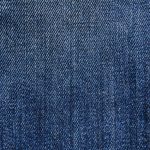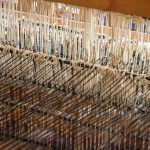You’ll find percale fabric offers a crisp, smooth texture that feels soft yet invigoratingly firm. Its tight, one-over-one-under weave creates a matte finish and lightweight fabric that stays breathable and cool, making it great for warmer nights. While not as silky as sateen, percale balances durability with comfort, and its softness can improve with proper care. If you want to explore how percale’s qualities impact your bedding choice, there’s more to discover ahead.
Table of Contents
Key Takeaways
- Percale fabric is crisp and smooth but not overly soft, offering a refreshing firmness with a matte, lightweight texture.
- Its tight plain weave creates a cool, breathable feel that balances softness and durability.
- Higher thread counts (200-400) in percale enhance softness while maintaining its characteristic crispness.
- Percale differs from sateen by providing a matte finish and cooler touch rather than a silky softness.
- Proper care, like gentle washing and low-heat drying, preserves percale’s crisp texture and softness over time.
What Is Percale Fabric?
Percale fabric is a type of closely woven cotton or cotton-blend textile known for its crisp, smooth feel. When you touch percale, you’ll notice its matte finish and lightweight texture, making it a popular choice for bedding.
It’s made using a plain weave, where the threads are tightly interlaced in a one-over-one-under pattern, giving you durability and breathability. Percale typically has a thread count ranging from 180 to 200, which strikes a balance between softness and strength.
You’ll find that percale holds up well to regular washing, maintaining its fresh and cool sensation over time. If you want bedding that feels clean and crisp every night, percale fabric is a reliable option to evaluate.
How Percale Weave Influences Softness
One key factor that shapes the softness you feel in this fabric is its weave structure. Percale uses a simple, tight one-over-one-under pattern that creates a smooth, matte finish. This weave keeps the fabric crisp yet breathable, giving you a new, clean feel. Unlike looser weaves, percale’s tight interlacing boosts durability without sacrificing softness. Here’s how the weave influences key qualities:
| Feature | Effect on Softness | Your Experience |
|---|---|---|
| Tight Weave | Creates smoothness | Crisp, cool touch |
| Matte Finish | Minimizes shine | Subtle, refined look |
| High Thread Count | Adds softness | Luxuriously gentle feel |
You’ll notice how this structure balances softness with a revitalizing firmness that’s perfect for comfortable bedding.
Comparing Percale to Other Cotton Weaves
When you compare percale to sateen, you’ll notice percale has a crisp, matte finish while sateen feels silkier and more lustrous.
The key difference lies in their weave density—percale uses a tight, one-over-one-under pattern, making it breathable and cool.
Understanding these distinctions helps you pick the right cotton weave for your comfort.
Percale vs. Sateen
The feel of your bedding can change dramatically depending on the weave, and comparing percale to sateen highlights these differences clearly. Percale boasts a crisp, matte finish with a lightweight, breathable texture, perfect if you prefer cool nights. Sateen, on the other hand, feels silky and smooth with a subtle sheen, offering a warmer, more luxurious touch.
| Feature | Percale | Sateen |
|---|---|---|
| Texture | Crisp and matte | Silky and smooth |
| Breathability | Highly breathable | Less breathable |
| Warmth | Cooler feel | Warmer feel |
Choosing between them depends on whether you want freshness or softness in your sheets.
Weave Density Differences
Although percale shares its basic cotton composition with other weaves, its weave density sets it apart and directly affects its texture and durability.
When you compare percale to other cotton weaves like sateen or flannel, you’ll notice distinct differences in thread count and weave tightness.
Here’s what you can expect with percale’s weave density:
- Higher thread count (usually 180-200) for a crisp, breathable feel.
- A plain weave pattern that creates a matte finish and smooth surface.
- Enhanced durability that resists pilling and holds up over time.
This combination means you get a fabric that feels fresh and cool, perfect if you want bedding that’s both soft and long-lasting without sacrificing structure or airflow.
Factors That Affect Percale’s Texture
You’ll notice Percale’s texture changes based on thread count and the type of fiber used.
Higher thread counts usually mean a smoother feel, while different fibers can affect softness and durability.
Let’s explore how these factors shape the overall touch of Percale fabric.
Thread Count Impact
When you choose percale bedding, thread count plays an essential role in determining its texture. Percale typically has a thread count between 200 and 400, which balances softness with that signature crispness you’re after.
Here’s why thread count matters:
- Lower Counts (below 200): You’ll get a rougher, less durable fabric that might feel scratchy.
- Optimal Counts (200-400): Expect a smooth, breathable, and crisp texture that softens with each wash.
- Higher Counts (above 400): It can feel heavier and lose the classic percale coolness and crispness you love.
Choosing the right thread count means you won’t sacrifice percale’s unique breathable feel or its lasting durability.
Fiber Material Types
Since the fiber material directly influences percale’s feel and durability, choosing the right one is essential.
When you pick percale made from 100% cotton, you get a breathable, soft, and naturally crisp fabric that improves with each wash. Cotton percale is durable and comfortable, making it a popular choice.
If you opt for polyester or a cotton-polyester blend, the texture feels smoother but less breathable, and it may lack the natural crispness you expect from percale.
Linen percale offers a cool, textured feel but can be rougher initially. Knowing these differences helps you select percale that matches your comfort needs.
The Breathability of Percale Sheets
Although many types of bedding promise comfort, percale sheets stand out because of their exceptional breathability. You’ll notice how their tight yet lightweight weave allows air to flow freely, keeping you cool throughout the night.
This breathability not only helps regulate your body temperature but also reduces moisture buildup, so you wake up feeling fresh and dry.
Here’s why you’ll love the breathability of percale sheets:
- They prevent overheating, making hot nights more comfortable.
- Their moisture-wicking ability keeps sweat from sticking to your skin.
- The crisp texture stays breathable, even after multiple washes.
Choosing percale means choosing a cooler, more comfortable sleep experience every night.
How Percale Feels Over Time
As you continue using percale sheets, you’ll notice their texture changes in a way that enhances comfort.
Initially crisp and cool, percale softens with each wash without losing its characteristic smoothness and matte finish. This gentle break-in process reduces any initial stiffness, making the fabric feel more inviting against your skin.
Unlike some fabrics that become limp or lose structure, percale maintains its durability and breathable quality, offering consistent comfort night after night.
The subtle softening also helps percale better conform to your body, improving your overall sleep experience.
Ideal Uses for Percale Bedding
Three qualities make percale bedding a top choice for many sleepers: breathability, durability, and a crisp texture.
These features make percale perfect for various uses, especially if you want bedding that stays fresh and cool.
Percale’s breathable nature keeps bedding feeling fresh and cool, ideal for restful, comfortable nights.
You’ll love percale bedding when:
- Sleeping in warm climates – Its breathable weave keeps you cool and sweat-free through the night.
- Enjoying a crisp, hotel-like feel – Percale offers a smooth, invigorating texture that feels luxurious against your skin.
- Looking for long-lasting bedding – Percale resists pilling and holds up well to frequent washing, maintaining its quality over time.
If you want bedding that combines comfort and resilience, percale is an ideal choice for your bedroom.
Caring for Percale to Maintain Softness
To keep your percale bedding feeling soft and fresh, you’ll need to follow a few simple care steps.
Wash your percale sheets in cold or warm water using a mild detergent to protect the fibers. Avoid bleach, as it can weaken the fabric and reduce softness. Use a gentle cycle to prevent excessive wear.
When drying, opt for a low heat setting or air dry to maintain the crisp texture without causing shrinkage. Remove the sheets promptly to minimize wrinkles, and consider ironing if you prefer an extra-smooth feel.
Avoid fabric softeners, which can leave residue and reduce the breathable quality of percale.
With these care tips, your percale bedding will stay crisp, comfortable, and soft for a long time.
Frequently Asked Questions
Can Percale Fabric Be Made From Materials Other Than Cotton?
You can find percale fabric made from materials besides cotton, like polyester or blends. These variations keep percale’s crisp, smooth feel but might change breathability and durability, so you’ll want to check the specific fabric content.
Is Percale Suitable for Allergy Sufferers?
You’ll find percale suitable if you have allergies because it’s tightly woven, reducing dust and allergens. Plus, it’s usually made from natural fibers like cotton, which helps keep your sleeping environment fresh and hypoallergenic.
How Does Percale Compare in Price to Sateen?
You’ll find percale generally costs less than sateen because it’s woven more simply. While sateen feels silkier and pricier, percale offers crispness at a budget-friendly price, making it a great value choice.
Can Percale Sheets Be Ironed Easily?
Ironing percale sheets is like smoothing out a calm lake’s surface; you’ll find it fairly easy. Just use a medium heat setting and a bit of steam to keep that crisp texture without damaging the fabric.
Does Percale Fabric Shrink After Washing?
Yes, percale fabric can shrink a bit after washing, especially if you use hot water or high heat drying. To avoid this, you should wash in cold water and tumble dry on low or air dry.
- Does Chiffon Fabric Stink - July 15, 2025
- Does Chiffon Fabric Affect the Economy - July 15, 2025
- Does Cotton Fabric Have a Nap - July 15, 2025







